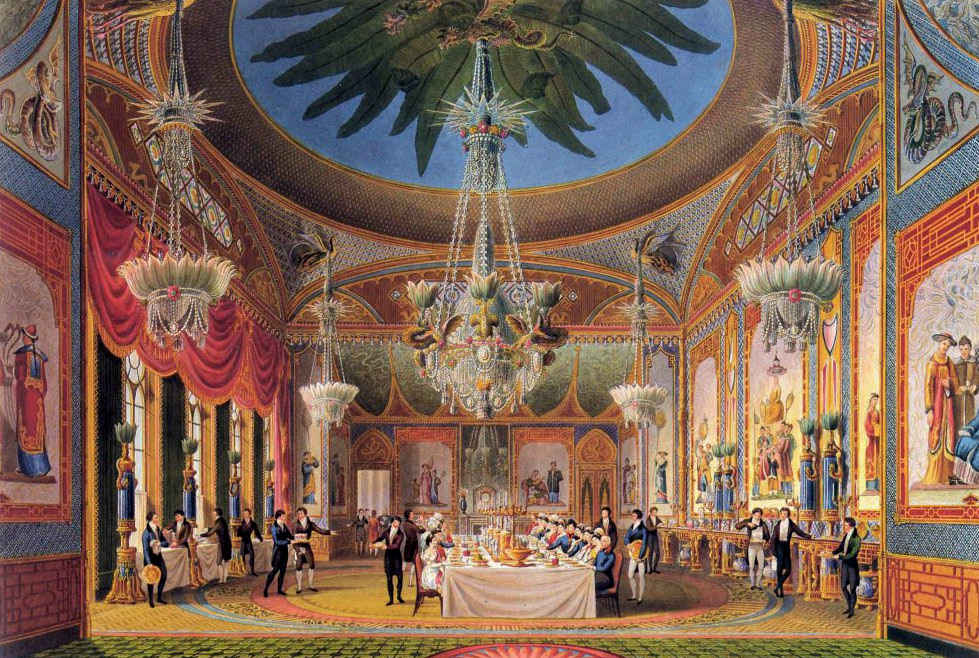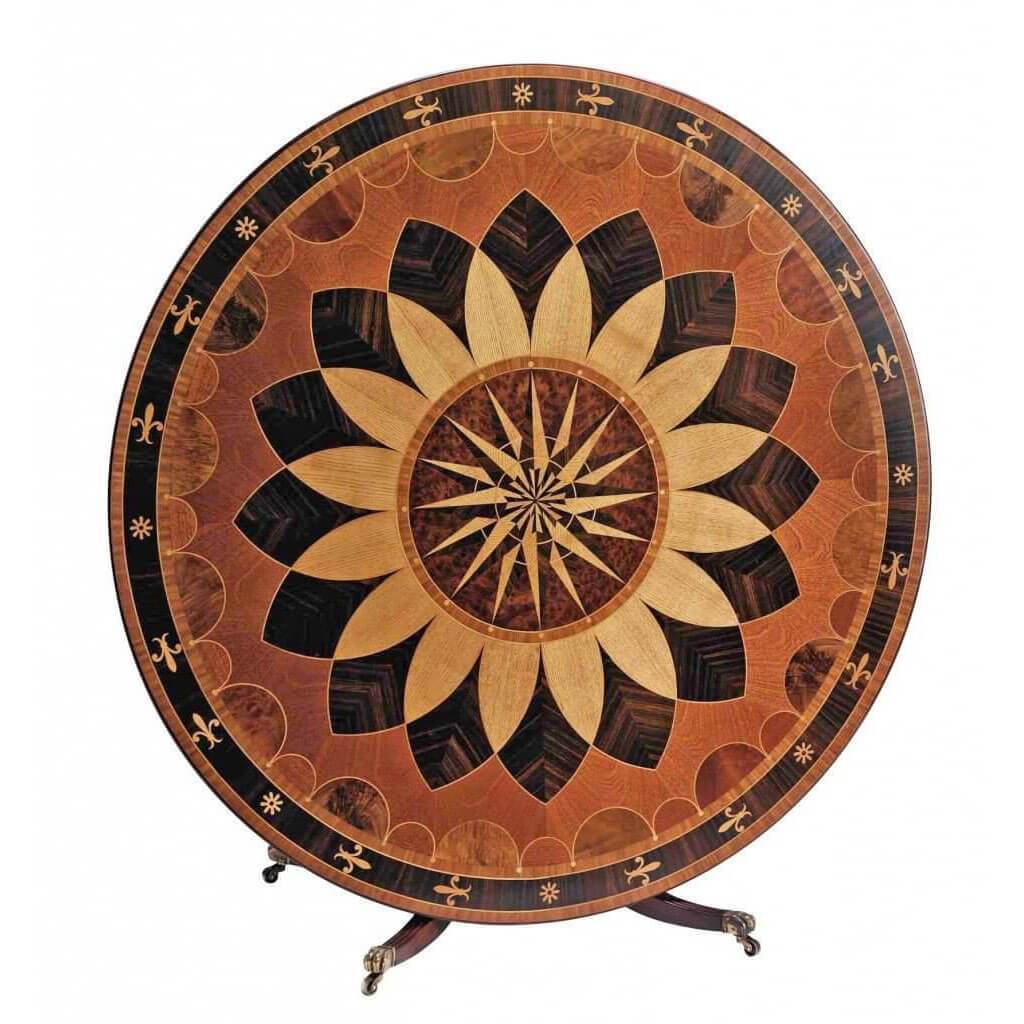“Portrait of George IV of England.” Painted by Thomas Lawrence in 1816. [Public domain] {{PD-US-expired}}
When you think of England's Regency era, a few things probably come to mind. Extravagance, high fashion, romance, and exoticism: any of these words can sum up the national mood and aesthetics of this era.
For those unfamiliar with this period in history, the Regency era gets its name from George IV, who was chosen to be Regent after his ailing father, King George III, was declared unfit for rule. The Prince ruled as Regent from the years 1811 through 1820, when his father passed away and he was named King George IV.
The Cultural Influences Behind Regency Style
As Prince Regent, George IV was a patron of the arts, and had a major influence on the interior design style, fashions, and architecture of the day. The Royal Pavilion in Brighton was built to be his personal retreat and directly reflected the Prince's tastes as well as the changing world around him.
Ancient Empires
Regency style is an extension of Neoclassical style from the 1700s, so columns and domes continued to be popular architectural features. Furniture makers of the 1800's also copied Greek and Roman furniture styles even more closely than Neoclassical designers had. Some of the ideas they borrowed included chairs with animal legs, couches with scrolled ends, and decorative lions and griffins.
This Regency-style convex mirror is sold by English Georgian America and features two gilded serpents. Click here for more information.
Another Regency reproduction by English Georgian America, this mahogany chest of drawers has both lion mask drop handles and lion’s paw feet. Available from their website.
Napoleon's campaign against the English in Egypt created renewed interest in Egyptian art among Europeans. Motifs taken from ancient Egyptian artifacts were incorporated into both the English Regency style and the French Empire style. The most popular motifs were crocodiles, birds of prey, and sun discs.
Asia
Where Neoclassical and Regency style differed was that Regency incorporated more visual ideas from Asia. The British East India Company, established in the 16th century, continued to import goods from China, Southeast Asia and India in the 1800s. Chinoiserie, which we covered in a previous blog, became even more popular in the Regency period.
The Banqueting Room at the Royal Pavilion in Brighton from John Nash's ''Views of the Royal Pavilion'' (1826). {PD-US-expired} Images of Chinese domestic scenes line the walls.
Before the Prince Regent's time, Chinoiserie style was usually reserved for bedrooms and tea pavilions. But that didn't stop George IV from filling his Royal Pavilion with Asian wallpaper, decorative dragons, paintings of Chinese domestic scenes, imitation bamboo, and lacquered furniture. Meanwhile, the exterior of the Royal Pavilion featured domes and minarets based on Indian architecture. At the time, many visitors found the Royal Pavilion's extravagant Asian decor shocking.
Modern Regency Interior Design
Decorating a home in Regency style today might seem intimidating. However, it can be done if you shop with the right kind of furnishings in mind. For those who don't collect antiques, there are many fine reproduction pieces available.
Furniture
During the Regency period, more foreign woods began to be imported to England. These included rosewood, satinwood (which has a bright yellow color), tulipwood, and zebrawood. Zebrawood was very costly, so it was generally used only in veneers and latticework. Brass inlays became a popular feature, as did ormolu, or imitation gold. Regency furniture was also usually finished with beautiful veneers.
When less expensive woods, such as beech, fir, or pine were used, they would be painted in black lacquer. Another popular paint color for furniture was green with a bronzy metal powder coating that simulated the look of a bronze patina.
While English Regency furniture is not as curvaceous as French Regency furniture from the 1700s, English designers did incorporate some curves, especially in the legs of furniture. Some other charming characteristics of Regency furniture include reeding, lion paw feet, and sabre legs. Reeding is a technique in which a wood surface has indentations carved into it to create a series of bands. The result looks a little bit like a bundle of reeds. Sabre legs are exactly what they sound like: furniture legs which curve outward like sabers.
On average, Regency chairs sit lower than modern chairs. Library and dining chairs were usually upholstered in leather, while sofas were richly upholstered in damask and satin. Speaking of sofas, it became very popular to include a sofa in every room in the Regency era.
Above, left: This stunning breakfast table by English Georgian America has an intricate, geometrically inlaid tilt top. Go to their website for a closer view.
Above, right: Black painted furniture is commonly seen in Regency style rooms. This Regency style dresser is also available in white from English Georgian America.
Colors
Neoclassical tended to have understated color schemes, but Regency style was more flamboyant. This is not a style for someone who doesn't love color.
The Royal Pavilion was heavily decorated in reds, pinks, greens, and gold. If you don't want to work with multiple bright colors in a room, pick just one and design the room around that color. For example, you could complement a pair of blue-and-white china pieces with cobalt blue drapes in the same room.
The blue silk pillow on this double chairback settee can add a touch of color to a space. This is another piece available at English Georgian America’s website.
Many Regency homes will have a bold accent wall with an exotic Chinoiserie pattern. Another option is the stately "Regency stripe" pattern, which alternates between light and dark stripes of the same width.
Accessories
An etagere resembling a Pagoda, such as this piece by English Georgian America, would have fit right in with the Brighton Pavilion’s Asian aesthetic. Currently in-stock at their website.
Accessories are another area where you can add a multicultural touch. In a Regency style room, it's not unusual to see foo dog statues, or Roman busts, paired with European style furnishings. Finally, make sure to have an eye-catching chandelier in any room that needs it. The more unique and spectacular the design is, the better.
When you set out to recreate Regency style in the modern-day, there is no need to turn your Dallas home into an opulent English palace. Instead, study the color palettes and furnishing choices you see in modern and classic Regency interiors. By drawing inspiration from what you see in photos, you can rework Regency style into a comfortable environment for yourself or your family.
If you're still stumped on how to combine the many different features of this style, seeking out an experienced interior designer should be your next step. To schedule a free consultation with us, email us at info@chambersinteriors.com or call our Dallas office at 214-651-7665.

![“Portrait of George IV of England.” Painted by Thomas Lawrence in 1816. [Public domain] {{PD-US-expired}}](https://images.squarespace-cdn.com/content/v1/555cbed8e4b0c2909e97a944/1547683001307-XI8Y07IBCZ49Y9EG7WYI/Thomas+Lawrence+%5BPublic+domain%5D+%7B%7BPD-US-expired%7D%7D)






